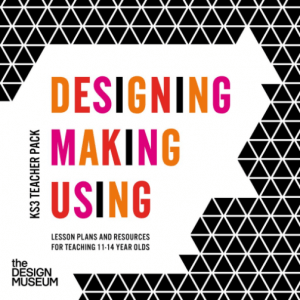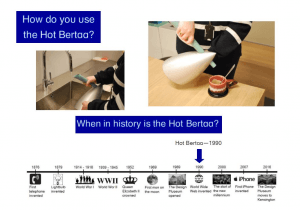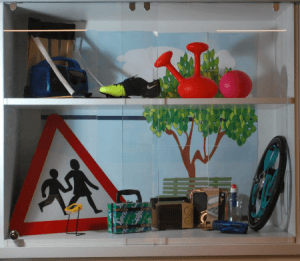Revitalising the Design Museum’s Handling Object Collection
| Sponsor: | The Design Museum |  |
| Sponsor Liaison: | David Houston | |
| Student Team: | Nicholas Maio, Benjamin Schooler, Natalie Thompson, Kaitlyn Valla | |
| Abstract: | The Design Museum in London has a unique handling object collection that is used in its learning workshops. These learning workshops complement and extend the U.K. national curriculum’s goals for the students’ design learning. Our project focused on helping the museum organise and present their handling collection. We created a database that was intuitive and informative for their staff and educators to help organise the items. We revitalised the information sheets for the objects in an effort to make them more accessible and memorable for students that attend the workshops. Finally, we curated the handling object collection in two different exhibits that are designed to show how items in the handling object collection are relevant and applicable to our daily lives. | |
| Link: | WPI Design Museum Final Report Final Presentation |
|
 Executive Summary
Executive Summary
Studies have shown that interaction with objects and other forms of hands-on activity enhance the cognitive development of children (Andre, Durksen, & Volman, 2016). Many museums are embracing hands-on learning through the introduction of handling object collections. These handling object collections consist of a multitude of objects which the museum visitors are allowed to touch and interact with. The Design Museum in London has a handling collection of its own that contains many common household objects and is used in the museum’s learning workshops for schools to teach about design. We were tasked with helping the Design Museum in London organise and revitalise its handling object collection in three different ways. First, we created a database for the handling object collection in order to help the museum educators and staff keep track of and organise their collection. Second, we recreated the information sheets that already existed for the objects to improve their educational value. Our goal with this objective was to create information sheets about the objects that were engaging and memorable. Our final objective was to curate the handling object collection into two distinct exhibits. One of the exhibits would be housed in the creative workshop learning space at the Design Museum while the other exhibit was displayed on the main exhibition floor in the Design Museum’s flagship exhibit, Designer Maker User. Before we could begin mocking up our database, information sheets, or exhibitions we needed to do a lot of background research in order to make informed decisions and relevant prototypes. Our research began by looking into various learning theories and styles relevant in the museum setting.
Museums are informal learning settings which are important for individuals who want to fill a gap in their knowledge or fulfil curiosity about a certain subject. When deciding on how the museum intends to present their information, they utilise the theory of knowledge and the theory of learning. These theories exist on a spectrum that defines knowledge as either something that exists independent of the person learning it or as something that exists only after the learner has experienced it. The intersection of these theories creates four different learning styles and museums most notably utilise the discovery and constructivist points of view which allow museum visitors to build on their past experiences while expanding their knowledge base. The focus of this project was primarily on how children experience discovery learning and prior research indicated that most children learn best when presented with visuals. Moreover, children respond best when presented with visuals that contain bright colours.
Along with visual presentations, tactile learning is very important when imparting information on young children and for this, many museums are embracing the concept of object-based learning through the use of handling collections. The Design Museum in London has a handling collection that they use in educational workshops which serves to ‘complement and extend’ the U.K. national curriculum’s compulsory subjects art and design and design and technology (Catherine Ritman-Smith, Head of Programme for Formal Learning at the Design Museum, personal communication, 10 April 2017).
Museums often capitalise on these learning strategies in their exhibits but they must also consider how engaging the exhibit is in order for the exhibit to reach its educational potential. It is important that museum visitors are able to relate to the exhibit on a personal level. It is also important that the exhibit is memorable so that it can leave a lasting impression on the visitor. The relevance and applicability to the museum visitor’s everyday life and the memorability of the exhibit are all ideas that we will need to keep in mind when designing our own exhibit.
We performed extensive research into different museum databasing systems and their ease of use and intuitiveness. We sought to determine the sorts of information that would be necessary to include in our own database while thinking about the sorts of things that make a database easy to use. We also needed to consider new users of the database after we left London and this inspired research into the creation of a user guide for our database. The user guides we found for other museum databases were often a simple icons on the webpage that, when clicked, would show the user a simple instructional guide on how to use the database. Once we had completed our research we felt that we had enough information to go forward into the prototyping phase.
Upon arriving in London, we began to research different databasing systems that would fulfil the needs of the Design Museum. By conducting interviews with the various staff and educators that would interact with the database, we were able to determine which features our database needed to have. These features were: searchability by keyword, image-based searching, the ability to update object condition in real time, and extensive information about the objects that includes links to external webpages that would offer more information. After testing Wikia, Google Sites, and Wikispaces, we found that Wikispaces best suited our needs. Wikia was not selected because it contained multiple random advertisements that detracted from the overall appearance of the site. We were also unable to control who had permission to view or edit pages in Wikia. Google Sites did not meet our needs because it was not freely searchable, we could not modify permissions, and we were unable to edit the HTML code of the website to add the additional features that the Design Museum requested.
After deciding on Wikispaces we then made further edits to the webpage by adding personalised widgets via new HTML code. We were able to embed a Google Form that will be used to keep track of the condition of the objects in the handling collection. We were also able to edit the homepage of the website so that the database could be searchable by the image of the objects rather than by the name of the object. All of these additions to the Wikispaces page were made at the request of the Design Museum staff and educators during the extensive interview process that occurred throughout the entire design process for our database. The homepage of our final database is shown in Figure 1.
Figure 1: Final Database Homepage
Before we landed in London, we had created three prototype information sheets based on our previous research. Most notably, our prototype information sheets were visually appealing with bright colours and soft borders. Once we arrived in London, we began to make changes to our prototypes based on interviews with Design Museum staff and educators as well as observations of the educational workshops and surveys of students. The most notable concept that stood out from our data collection was that context is very important when presenting information to children. Context, for our purposes, is defined as the relevancy and applicability to someone’s life and is important because it helps relate an object or concept to someone which can help them remember and learn from that object or concept. We were also able to evolve each sheet based on feedback from staff and from students. This feedback led to changes in things like layout, style, and content.
This process was very helpful in helping us make improvements to our information sheets, however, it did not demonstrate that one information sheet was superior to another. Therefore, we had to conduct another survey which would help us select a specific prototype to be finalised and presented to the Design Museum. We conducted a poll of museum visitors and asked them to vote on which information sheet layout they found most interesting and accessible for children. From this survey, we found that our third prototype was the most popular. This prototype was a horizontal layout which was relatively simple and had a large picture of the object. Once this prototype was selected, we made small finalisation changes and presented it to the Design Museum for use in their workshops. The final information sheet format is shown in Figures 2 and 3.
Figure 2: Final Information Sheet (Front)
Figure 3: Final Information Sheet (Back)
To execute the last deliverable of our project, the curation of two exhibits displaying the handling collection, we conducted extensive interviews with curatorial staff and observations of museum visitors. Using these two methods, we found several common threads which guided our curation process. First, we found from curatorial staff at the Design Museum and other museums that it is important that an exhibit tells a story. This story creates a singular and consistent narrative that relates to every object within the exhibit. Additionally, we found that context is again a very important thing to keep in mind while curating an exhibit. Along with a singular narrative, context helps relate the exhibit to the exhibit viewer. We also wanted to figure out how to present the exhibits. We decided to observe our audience, which we found to be students and families with young children, in order to find out what type of exhibit they would be most likely to engage with. From these observations, we found that students and families were very likely to engage with interactive exhibits as compared to the rest of the museum visitors.
With these concepts in mind, we started to come up with the ideas for our exhibit. For the exhibit on the main museum floor which dealt with materials, we wanted to demonstrate the use of materials in everyday products and the reasons these materials were selected for those products. This narrative would be used throughout the exhibit to demonstrate this desired concept of material use. We presented this in an interactive way by displaying the material covering a case which contains a common object made out of that material. This material can be removed and handled by a museum visitor to reveal the common object within the case. Figure 4 shows this concept.
Figure 4: Display Case Concept
Additionally, we curated the learning handling collection in display cabinets in the creative workshops generally used as a setting to teach student groups about design using the handling collection. These display cabinets could not be interacted with by museum visitors or students, but we were still able to contextualise the collection and tell a story. We did this by separating the cabinets into the rooms of the house. Each cabinet section would house a number of objects which would generally be found in their respective rooms. In back of the cabinets would be a backdrop depicting each room. This would contextualise the objects for people viewing the collection for the first time. The display fits each object within a singular narrative which flows throughout the exhibit. An example workshop cabinet setting is shown in Figure 5.
Figure 5: Implemented Workshop Cabinet Outdoor Scene
We have completed each of our three deliverables, create a database, recreate information sheets, and curate two exhibits. We believe that the final products which we have presented to the Design Museum will give new life to the handling collection. In the future, this collection will be better organised and more accessible. Additionally, the workshops will be much improved with our new information sheets which are valuable educational tools. Finally, the museum now has a great way of presenting the handling collection in the creative workshops and on the main museum floor which helps extend the collection to a wider museum audience.







